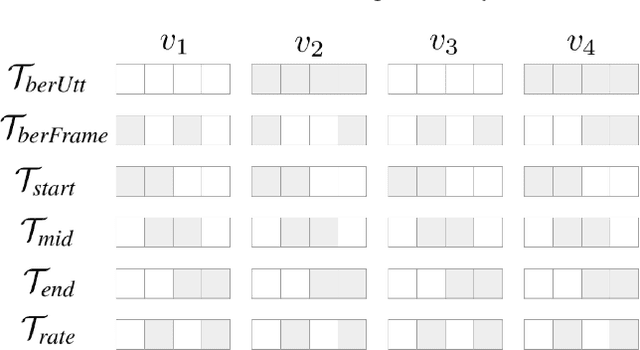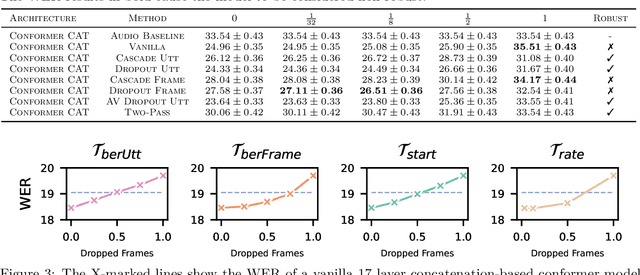Oscar Chang
Gemini Robotics: Bringing AI into the Physical World
Mar 25, 2025Abstract:Recent advancements in large multimodal models have led to the emergence of remarkable generalist capabilities in digital domains, yet their translation to physical agents such as robots remains a significant challenge. This report introduces a new family of AI models purposefully designed for robotics and built upon the foundation of Gemini 2.0. We present Gemini Robotics, an advanced Vision-Language-Action (VLA) generalist model capable of directly controlling robots. Gemini Robotics executes smooth and reactive movements to tackle a wide range of complex manipulation tasks while also being robust to variations in object types and positions, handling unseen environments as well as following diverse, open vocabulary instructions. We show that with additional fine-tuning, Gemini Robotics can be specialized to new capabilities including solving long-horizon, highly dexterous tasks, learning new short-horizon tasks from as few as 100 demonstrations and adapting to completely novel robot embodiments. This is made possible because Gemini Robotics builds on top of the Gemini Robotics-ER model, the second model we introduce in this work. Gemini Robotics-ER (Embodied Reasoning) extends Gemini's multimodal reasoning capabilities into the physical world, with enhanced spatial and temporal understanding. This enables capabilities relevant to robotics including object detection, pointing, trajectory and grasp prediction, as well as multi-view correspondence and 3D bounding box predictions. We show how this novel combination can support a variety of robotics applications. We also discuss and address important safety considerations related to this new class of robotics foundation models. The Gemini Robotics family marks a substantial step towards developing general-purpose robots that realizes AI's potential in the physical world.
Holistic Safety and Responsibility Evaluations of Advanced AI Models
Apr 22, 2024Abstract:Safety and responsibility evaluations of advanced AI models are a critical but developing field of research and practice. In the development of Google DeepMind's advanced AI models, we innovated on and applied a broad set of approaches to safety evaluation. In this report, we summarise and share elements of our evolving approach as well as lessons learned for a broad audience. Key lessons learned include: First, theoretical underpinnings and frameworks are invaluable to organise the breadth of risk domains, modalities, forms, metrics, and goals. Second, theory and practice of safety evaluation development each benefit from collaboration to clarify goals, methods and challenges, and facilitate the transfer of insights between different stakeholders and disciplines. Third, similar key methods, lessons, and institutions apply across the range of concerns in responsibility and safety - including established and emerging harms. For this reason it is important that a wide range of actors working on safety evaluation and safety research communities work together to develop, refine and implement novel evaluation approaches and best practices, rather than operating in silos. The report concludes with outlining the clear need to rapidly advance the science of evaluations, to integrate new evaluations into the development and governance of AI, to establish scientifically-grounded norms and standards, and to promote a robust evaluation ecosystem.
Gemma: Open Models Based on Gemini Research and Technology
Mar 13, 2024



Abstract:This work introduces Gemma, a family of lightweight, state-of-the art open models built from the research and technology used to create Gemini models. Gemma models demonstrate strong performance across academic benchmarks for language understanding, reasoning, and safety. We release two sizes of models (2 billion and 7 billion parameters), and provide both pretrained and fine-tuned checkpoints. Gemma outperforms similarly sized open models on 11 out of 18 text-based tasks, and we present comprehensive evaluations of safety and responsibility aspects of the models, alongside a detailed description of model development. We believe the responsible release of LLMs is critical for improving the safety of frontier models, and for enabling the next wave of LLM innovations.
Gemini 1.5: Unlocking multimodal understanding across millions of tokens of context
Mar 08, 2024Abstract:In this report, we present the latest model of the Gemini family, Gemini 1.5 Pro, a highly compute-efficient multimodal mixture-of-experts model capable of recalling and reasoning over fine-grained information from millions of tokens of context, including multiple long documents and hours of video and audio. Gemini 1.5 Pro achieves near-perfect recall on long-context retrieval tasks across modalities, improves the state-of-the-art in long-document QA, long-video QA and long-context ASR, and matches or surpasses Gemini 1.0 Ultra's state-of-the-art performance across a broad set of benchmarks. Studying the limits of Gemini 1.5 Pro's long-context ability, we find continued improvement in next-token prediction and near-perfect retrieval (>99%) up to at least 10M tokens, a generational leap over existing models such as Claude 2.1 (200k) and GPT-4 Turbo (128k). Finally, we highlight surprising new capabilities of large language models at the frontier; when given a grammar manual for Kalamang, a language with fewer than 200 speakers worldwide, the model learns to translate English to Kalamang at a similar level to a person who learned from the same content.
Single-channel speech enhancement using learnable loss mixup
Dec 20, 2023



Abstract:Generalization remains a major problem in supervised learning of single-channel speech enhancement. In this work, we propose learnable loss mixup (LLM), a simple and effortless training diagram, to improve the generalization of deep learning-based speech enhancement models. Loss mixup, of which learnable loss mixup is a special variant, optimizes a mixture of the loss functions of random sample pairs to train a model on virtual training data constructed from these pairs of samples. In learnable loss mixup, by conditioning on the mixed data, the loss functions are mixed using a non-linear mixing function automatically learned via neural parameterization. Our experimental results on the VCTK benchmark show that learnable loss mixup achieves 3.26 PESQ, outperforming the state-of-the-art.
Revisiting the Entropy Semiring for Neural Speech Recognition
Dec 19, 2023



Abstract:In streaming settings, speech recognition models have to map sub-sequences of speech to text before the full audio stream becomes available. However, since alignment information between speech and text is rarely available during training, models need to learn it in a completely self-supervised way. In practice, the exponential number of possible alignments makes this extremely challenging, with models often learning peaky or sub-optimal alignments. Prima facie, the exponential nature of the alignment space makes it difficult to even quantify the uncertainty of a model's alignment distribution. Fortunately, it has been known for decades that the entropy of a probabilistic finite state transducer can be computed in time linear to the size of the transducer via a dynamic programming reduction based on semirings. In this work, we revisit the entropy semiring for neural speech recognition models, and show how alignment entropy can be used to supervise models through regularization or distillation. We also contribute an open-source implementation of CTC and RNN-T in the semiring framework that includes numerically stable and highly parallel variants of the entropy semiring. Empirically, we observe that the addition of alignment distillation improves the accuracy and latency of an already well-optimized teacher-student distillation model, achieving state-of-the-art performance on the Librispeech dataset in the streaming scenario.
Gemini: A Family of Highly Capable Multimodal Models
Dec 19, 2023Abstract:This report introduces a new family of multimodal models, Gemini, that exhibit remarkable capabilities across image, audio, video, and text understanding. The Gemini family consists of Ultra, Pro, and Nano sizes, suitable for applications ranging from complex reasoning tasks to on-device memory-constrained use-cases. Evaluation on a broad range of benchmarks shows that our most-capable Gemini Ultra model advances the state of the art in 30 of 32 of these benchmarks - notably being the first model to achieve human-expert performance on the well-studied exam benchmark MMLU, and improving the state of the art in every one of the 20 multimodal benchmarks we examined. We believe that the new capabilities of Gemini models in cross-modal reasoning and language understanding will enable a wide variety of use cases and we discuss our approach toward deploying them responsibly to users.
On Robustness to Missing Video for Audiovisual Speech Recognition
Dec 19, 2023



Abstract:It has been shown that learning audiovisual features can lead to improved speech recognition performance over audio-only features, especially for noisy speech. However, in many common applications, the visual features are partially or entirely missing, e.g.~the speaker might move off screen. Multi-modal models need to be robust: missing video frames should not degrade the performance of an audiovisual model to be worse than that of a single-modality audio-only model. While there have been many attempts at building robust models, there is little consensus on how robustness should be evaluated. To address this, we introduce a framework that allows claims about robustness to be evaluated in a precise and testable way. We also conduct a systematic empirical study of the robustness of common audiovisual speech recognition architectures on a range of acoustic noise conditions and test suites. Finally, we show that an architecture-agnostic solution based on cascades can consistently achieve robustness to missing video, even in settings where existing techniques for robustness like dropout fall short.
Principled Weight Initialization for Hypernetworks
Dec 13, 2023Abstract:Hypernetworks are meta neural networks that generate weights for a main neural network in an end-to-end differentiable manner. Despite extensive applications ranging from multi-task learning to Bayesian deep learning, the problem of optimizing hypernetworks has not been studied to date. We observe that classical weight initialization methods like Glorot & Bengio (2010) and He et al. (2015), when applied directly on a hypernet, fail to produce weights for the mainnet in the correct scale. We develop principled techniques for weight initialization in hypernets, and show that they lead to more stable mainnet weights, lower training loss, and faster convergence.
Balanced and Deterministic Weight-sharing Helps Network Performance
Dec 13, 2023Abstract:Weight-sharing plays a significant role in the success of many deep neural networks, by increasing memory efficiency and incorporating useful inductive priors about the problem into the network. But understanding how weight-sharing can be used effectively in general is a topic that has not been studied extensively. Chen et al. [2015] proposed HashedNets, which augments a multi-layer perceptron with a hash table, as a method for neural network compression. We generalize this method into a framework (ArbNets) that allows for efficient arbitrary weight-sharing, and use it to study the role of weight-sharing in neural networks. We show that common neural networks can be expressed as ArbNets with different hash functions. We also present two novel hash functions, the Dirichlet hash and the Neighborhood hash, and use them to demonstrate experimentally that balanced and deterministic weight-sharing helps with the performance of a neural network.
 Add to Chrome
Add to Chrome Add to Firefox
Add to Firefox Add to Edge
Add to Edge